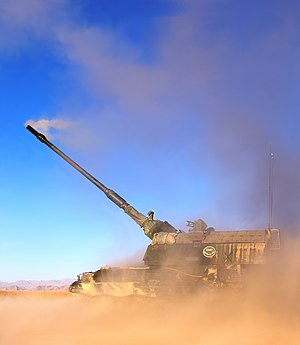Battle of Chora
| date | June 15-19, 2007 |
|---|---|
| place | Urusgan Province , Afghanistan |
| output | Allied tactical victory |
| consequences | Strategic results unclear, conflict persists |
| Parties to the conflict | |
|---|---|
| Commander | |
|
Colonel Hans van Griensven |
Mullah Mutalib † |
| Troop strength | |
| 700–800 soldiers | unknown, probably a few hundred |
| losses | |
|
Netherlands: |
Taliban: |
The Battle of Chora took place from June 15 to 19, 2007 within and around the city of Chora in the Afghan province of Urusgan . The fighting was fought over control of an important supply route between ISAF troops and their Afghan allies on the one hand and the Taliban on the other.
prehistory
The province of Urusgan, along with the neighboring provinces of Kandahar and Helmand, is part of the traditional Pashtun tribal area of the Taliban. In a coalition led by the United States in August 2006, 1,600 Dutch soldiers have already been relocated to the provincial capital. Australian and Afghan troops under Dutch command and other NATO allies were also stationed there. Due to the spatial expansion of the operating room, the Dutch high command decided to concentrate its troops only on the three metropolitan areas.
The battle
15th June
On the evening of June 15, 2007, several firefights took place near Chora. On the morning of the same day, a Dutch convoy was attacked by a suicide bomber . Several Afghan civilians were killed in the process.
June 16
A US A-10 - ground attack aircraft cleared to about 60 people, snaking their way to Chora. The Dutch troops were informed, but the group was not attacked as it could not be clearly identified.
A short time later, three Afghan police checkpoints were attacked in a coordinated manner by a large number of Taliban. The Dutch media reported a number of around 800 attackers, but this could not be confirmed. Dutch troops were deployed in the course of the fighting to support two of the police stations.
The Taliban raided one of the checkpoints and killed a police officer they captured and members of his family. In the afternoon, Dutch troops were forced to evade, allowing the Taliban to take the remaining two checkpoints.
The Dutch troops reassembled at Chora. The Dutch commander, Colonel Hans van Griensven , gave orders to hold the position and continue fighting.
ISAF air forces offered air support and attacked the Taliban, also investigating around 30 Bosnian militants who were together on a farm near a village. An Apache attack helicopter fired two Hellfire missiles at the farm, killing the rioters and several civilians.
Rozi Khan, a local tribal leader, offered to deploy 150 to 200 of his men to defend Chora. The Dutch and the mayor of Chora were reluctant to accept his offer. A group of Dutch and Australian soldiers in Kamp Holland moved in the direction of Chora, with the Australians securing an important access road.
On June 16, US Staff Sergeant Roy P. Lewsader was killed when his vehicle was hit by an RPG anti-tank weapon .
June 17th and 18th
On Sunday June 17th and Monday June 18th the Dutch reinforcements from Kamp Holland and a second Dutch base reached the troops at Chora and increased the number of soldiers to 500 men. With the help of Chinook transport helicopters , 50 Afghan soldiers were also transferred to the combat area.
Six F-16 fighter aircraft of the Dutch armed forces stationed in Afghanistan were requested by infantry forces during the fighting and supported the ground forces in the battle.
On the night of June 18, a Dutch soldier was killed and three others injured when a grenade detonated in the barrel while an 81 mm mortar was being reloaded.
June 19th
At 9:30 a.m., NATO ordered the cessation of air support for the fighting around Chora, but air strikes resumed at 9:40 a.m. after Colonel Van Griensven threatened to withdraw his six F-16s from NATO high command.
At 10:00 am, Dutch and Afghan troops, together with Rozi Khan's militias, carried out the so-called "Operation Troy" to recapture the three lost control posts.
Individual evidence
- ↑ http://www.icasualties.org/oef/Afghanistan.aspx
- ↑ http://www.usatoday.com/news/world/2007-06-18-afghanistan-airstrike_N.htm
- ↑ http://www.icasualties.org/oef/default.aspx
- ↑ a b c d e http://www.volkskrant.nl/binnenland/article438392.ece/Infanteristen,_commando_s_iedereen_vecht_tegen_Taliban
- ↑ a b c d e http://oruzgan.web-log.nl/uruzgan_weblog/2008/01/uruzgan_het_gev.html
- ↑ a b http://www.volkskrant.nl/binnenland/article439853.ece/Ze_schoten_een_magazijn_op_me_leeg
